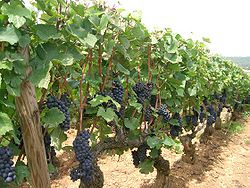 |
| Pinot vines |
One of my most memorable wine experiences involved a bottle of Pinot noir from the Burgundy region of France. The wine had been given to Barb and I by my son Dominic who in turn received it as a gift from the family he had lived with while he was an exchange student in college. According to Dominic the bottle, which was arbitrarily plucked from the family’s cellar, was not considered by his hosts to be anything special. It was simply the locally produced, inexpensive wine that they drank with their meals every day.
Lucky French.
The wine was extraordinary. It had a little age on it and this was evidenced by its brown-red color in the glass. But it had lost none of its vitality, and what was so remarkable was the way the wine evolved from the first sip to the last, that evolution showing the wide range of complex flavors and aromas that can be displayed in a well-made Pinot.
All red Burgundies are made exclusively from the Pinot noir grape. (White Burgundies are made from the ever-popular and ubiquitous Chardonnay.) Pinot noir is thin-skinned, difficult to cultivate, sensitive to wind and frost, and highly susceptible to the myriad fungi and diseases that attack grapes in the vitis vinefera family. It does best in cooler areas like Burgundy where vineyards of this rather unpredictable grape have been cultivated for centuries. Most of those vineyards are small, some as small as sixty acres, and in good years the wine that is produced by the incomparable First Growths are among the most dazzling and highest priced in the world. Unless you’re invited to a dinner hosted by Donald Trump or Bill Gates you’ll probably never get to taste one of those most exclusive wines: a bottle of Romanee-Conti recently sold at auction for $24,000. But take heart. There are plenty of domestic Pinots from California, Oregon, Washington and even Michigan that are delicious and relatively affordable.
 |
| Pinot clusters |
One of the words that I use to describe the wine is feminine. Pinots are graceful rather than bold, supple rather than muscular. Like a beautiful woman they are silky and sensuous. They tend to be lighter in color than the other red varietals and they have less tannin (the astringent, mouth puckering, often intimidating dryness that is evident in big, beefy reds). For this reason they are more approachable for folks making the transition from white wines to red. Well-made pinots will titillate the senses with their captivating flavors reminiscent of cherry, raspberry and strawberry and their beguiling aromas of earth and truffles.
Because of their low tannin and balanced acidity Pinots partner well with a wide variety of dishes. I love a good bottle of Pinot with roast chicken and it is always my first choice to have with duck. It goes well with pork roasts, pork chops, pork loin and ham. Making a light pasta dish for supper? Pair it with a Pinot.
Unless you move to France, Pinot noir probably won’t be the wine that you drink every day. It can be hard to find an inexpensive, well-made Pinot. But the next time you want a special bottle or two to go along with a special meal, think about the wine that made Burgundy famous. Then you too may find yourself groping for words to describe the experience.
 |
| Michigan, French, Oregon Pinot, respectively |
No comments:
Post a Comment